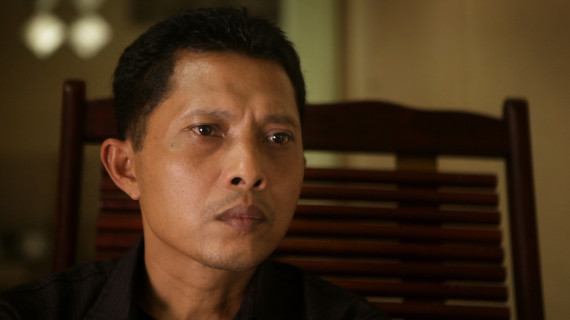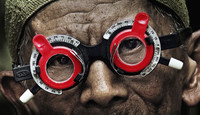
A decade ago, Joshua Oppenheimer filmed two men by an Indonesian riverbank as they recounted their part in a political genocide. The army had seized power in 1965, organizing gangs and Muslim groups to kill up to a million suspected leftists. As Oppenheimer described the scene in an email:
Two aging death squad leaders take me to a riverbank, reenacting with apparent glee how they helped the army to kill 10,500 people at a single clearing on the banks of the Snake River. At the end, they pose for snapshots -- souvenirs of what for them was a happy afternoon out. For me, though, it was among the most traumatic days of my life.
That afternoon was the genesis of two documentaries. In 2013's Oscar-nominated The Act of Killing, another aging gangster named Anwar Congo recreated his part in the killings as film noir, action movies and westerns, as well as staging lush musical numbers. (I wrote about it here). The surreal and macabre recreations were deeply unsettling, even as the near-total absence of victims allowed viewers to begin to identify with this likable grandfather, responsible for perhaps a thousand deaths by garrote and machete.
Some audiences described a resulting feeling of queasiness, and Oppenheimer also faced criticism for giving killers a platform to boast and lie. But this approach allowed perpetrators to implicate both themselves and a state still insisting on perverse fictions while rewarding killers with wealth and power. Oppenheimer always knew he would make a second movie. When The Act of Killing was finished -- but before it was released -- he rejoined Indonesian colleagues (kept anonymous for safety) to film a quiet optician named Adi, his fierce and furious mother, and his ancient father.
Fifty years ago, Adi's brother Ramli was taken from a prison camp to be executed. He was stabbed repeatedly before he escaped and crawled home, asking his mother for some hot coffee. In the morning men came for him, promising to bring him to a hospital. Instead, as his mother knew they would, they killed him by the river. Adi was born a couple of years later, a miracle to his grieving parents.
Adi had encouraged Oppenheimer to interview the boastful perpetrators, leading to the first film. The director showed him footage over the years, including the two men sunnily describing Ramli's death by the banks of the Snake. The look on Adi's face as he absorbs this scene partly inspired the title, The Look of Silence.
But the film is ultimately about speaking. Seeing his parents trapped in silence, and his children taught in school that their uncle's killers were heroes, Adi suggested something unprecedented: On camera, he would confront the men who killed his brother and thousands of others.
Not strictly a sequel, this film is most effective when watched after The Act of Killing. The first film depicted the lies the killers -- and the rest of us -- tell to live with terrible truths. In a glittering and gauzy sequence conceived by Congo, a victim lifts the garrote from his own neck, and offers the old gangster a medal and his gratitude, as "Born Free" swells in the background. As Oppenheimer explained to me, it is
"A film about escapism, fantasy... and guilt. Inevitably, it is a flamboyant film, a tropical Hieronymus Bosch, a fever dream."
The second film has a clear narrative and a true hero in Adi, and when he identifies himself as Ramli's brother, the mood shifts. The boasts and fantasies give way to denials, threats and demands to leave the past alone. In some countries, Holocaust denial is a crime. In Indonesia, it is progress.
Adi seems ready to attempt reconciliation if only he sees some remorse, and the title could also refer to the pauses during these confrontations. Adi's facial muscles twitch as he awaits a response, and in these moments it's possible to imagine that a victim has at last made the perpetrators fall silent in their shame.
Ultimately, Adi never gets the remorse he seeks, but we get a glimpse of what is possible. A daughter appears shaken to hear her father describe drinking the blood of his victims (a superstitious effort to ward off insanity), and apologizes for him. The film focuses on this personal level, especially through the deeply intimate view of Adi's family. There are only hints of the role larger forces played in the 1965 killings such as the Indonesian army, the U.S. government, and the Cold War. Asked about these gaps at the NY Film Festival, Oppenheimer agreed these were crucial topics, but were not his subject.
The films have a purpose apart from a political expose, and distinct from each other. Oppenheimer has described the first as a bomb to blow open the space to talk about the past, while The Look of Silence hints at how to fill that space with the truth, and then perhaps justice and healing. Sociologist Ariel Heryanto writes:
The Look of Silence offers a glimmer of hope for the future of Indonesia. It provides a model and an inspiration for Indonesian audiences to dare to confront and accuse those involved in the violence of 1965-66, violence that, to this day, some deny while others glorify.
I will give the remarkable Adi the last word, in a message sent to me through Oppenheimer:
When I first told Joshua that I wanted to meet the perpetrators, he refused. He felt it would be too dangerous. But I explained why: I wanted them to acknowledge what they did was wrong. I hoped that by meeting me, a brother of one of their victims, they would be forced to realize they killed human beings, and acknowledge it was wrong... This way, we could live side by side as human beings, instead of as perpetrator and victim, divided by mutual suspicion and fear. In this way, I hoped to lift my family out of the trap of fear in which we were living for so long.
The Look of Silence is showing at film festivals before a US release in Summer 2015. The trailer is here.
Photos credit Lars Skree, Final Cut for Real

